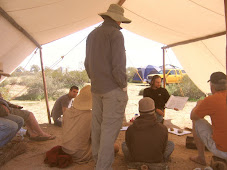 While in America "thin is in," in some cultures around the world "fat is where it's at." One such culture can be found in the desert-streaked country of Mauritania, located in West Africa. Here, the true marker of beauty and health in a woman is the amount of rolls she has. But there's one problem: human beings eating normal amounts of natural foods don't get obese and overweight, and the common foods available in West Africa include raw goat's milk, meat, millet, couscous, dates, peanuts, and other whole foods. While most of us in the Western world can easily become fat through years of eating fattening, unnatural, metabolism-altering foods like high-fructose corn syrup, trans-fats, and high-gluten white flour, the Mauritanian people don't have such "luxuries" -- so they resort to good old-fashioned force-feeding to accomplish the task.
While in America "thin is in," in some cultures around the world "fat is where it's at." One such culture can be found in the desert-streaked country of Mauritania, located in West Africa. Here, the true marker of beauty and health in a woman is the amount of rolls she has. But there's one problem: human beings eating normal amounts of natural foods don't get obese and overweight, and the common foods available in West Africa include raw goat's milk, meat, millet, couscous, dates, peanuts, and other whole foods. While most of us in the Western world can easily become fat through years of eating fattening, unnatural, metabolism-altering foods like high-fructose corn syrup, trans-fats, and high-gluten white flour, the Mauritanian people don't have such "luxuries" -- so they resort to good old-fashioned force-feeding to accomplish the task.The Mauritanian fattening practice, called leblouh, takes place when young women enter a tiny sandstone hut. Inside resides an old woman, the "fattener," whose primary job in the community is to make sure these young women (sometimes beginning as young as 5-years-old) become plump and, thus, attractive and suitable for marraige.
Obvious moral and ethical implications of this practice aside, I thought it would be interesting to find out just how much food is utilized to accomplish the fattening. I was surprised to find out that these women typically are force-fed -- to the point of nasuea and vomiting at times -- a whole-foods diet of up to 16,000 calories. This includes four meals per day of:
...crushed dates and peanuts with couscous and oil ... cloying, egg-size balls of around 300 calories apiece. Each girl eats about 40 per day, along with 12 pints of goat's milk and gruel ... (Source)
To bolster the fattening process, the women also must not get any exercise whatsoever, remaining in the huts for several years until they are married off. Additionally, because the task of eating such inordinate amounts of food is so physically challenging to the young women, the old woman "fattener" threatens to beat them if they refuse to eat.
Because the Mauritanian women are limited to traditional foods, which lead to satiety rather quickly due to high nutrient content and are difficult to overeat, some have sought out methods to increase their appetite unnaturally to be able to gain those extra pounds of beauty. One such method is the purchase of certain pharmaceuticals:
Sold secretly at city markets, they include hormones used to fatten camels and chickens, and steroids for asthma and cancer ... (Source)
The difficulty inherent in these traditional peoples' ability to gain weight while eating whole foods challenges the notion, once again, that carbohydrates lead to obesity. Here we have a culture whose only way of fattening young women is by force-feeding them massive amounts of proteins, carbohydrates, and fats. If to fatten the young women it was only necessary to emphasize carbohydrates in the diet, as Gary Taubes and other low-carb proponents might suggest, then why must the women be forced to eat excessive amounts food to become overweight? Why not just eat millet and couscous and dates? Many modernized folks seem to have no trouble at all gaining unneeded weight while eating far less than 16,000 calories. Yet these Mauritanian women must resort to appetite increasing drugs or the threat of a beating while eating about that much food to do the same:
Although hardly skeletal at 5'6" and 180 pounds, Hawer [a 26-year-old Mauritanian woman] says she has trouble piling on weight, and was teased by plumper girls as a teenager. Recently, her husband told her that he "didn't like sleeping with a bag of bones. Desperate to be bigger, Hawer uses drugs to aid weight gain." (Source)
It's the quality of food that's the difference. Traditional versus modern food. High-fructose corn syrup, one the great fatteners in the indutrialized nations, would be a prized commodity in Mauritania.
One other interesting observation is that the older women in the culture, who have already gone through the fattening process during their younger years and have resumed eating a normal amount of traditional foods, appear to be at a healthy weight. Did they diet to lose their weight? I doubt it. Below is a picture of women who are campaigning against the practice of leblouh. All have gone through the leblouh in their youth, and none of them remain overweight:





